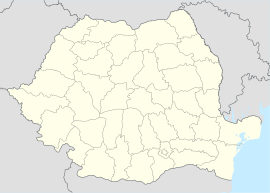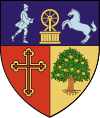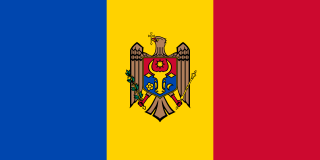
Moldova, officially the Republic of Moldova, is a landlocked country in Eastern Europe. It is bordered by Romania to the west and Ukraine to the north, east, and south. The capital city is Chișinău.

Romania is a country located at the crossroads of Central, Eastern, and Southeastern Europe. It borders on the Black Sea to the southeast, and with Bulgaria to the south, Ukraine to the north, Hungary to the west, Serbia to the southwest, and Moldova to the east. It has a predominantly temperate-continental climate. With a total area of 238,397 square kilometres, Romania is the 12th-largest country in Europe and the 6th most populous member state of the European Union, having approximately 20 million inhabitants. Its capital and largest city is Bucharest. Other major urban areas include: Cluj-Napoca, Timișoara, Iași, Constanța, Craiova, Brașov, and Galați.

Romanian is a Balkan Romance language spoken by approximately 24–26 million people as a native language, primarily in Romania and Moldova, and by another 4 million people as a second language. According to another estimate, there are about 34 million people worldwide who can speak Romanian, out of which 30 million speak it as a native language. It is an official and national language of both Romania and Moldova and is one of the official languages of the European Union.

Transylvania is a historical region which is located in central Romania. Bound on the east and south by its natural borders, the Carpathian mountain range, historical Transylvania extended westward to the Apuseni Mountains. The term sometimes encompasses not only Transylvania proper, but also parts of the historical regions of Crișana and Maramureș, and occasionally the Romanian part of Banat.

Bucharest is the capital and largest city of Romania, as well as its cultural, industrial, and financial centre. It is located in the southeast of the country, at 44°25′57″N26°06′14″E, on the banks of the Dâmbovița River, less than 60 km (37.3 mi) north of the Danube River and the Bulgarian border.

Nicolae Ceaușescu was a Romanian communist politician and leader. He was the general secretary of the Romanian Communist Party from 1965 to 1989 and hence the second and last Communist leader of Romania. He was also the country's head of state from 1967, serving as President of the State Council and from 1974 concurrently as President of the Republic until his overthrow and execution in the Romanian Revolution in December 1989, part of a series of anti-Communist and anti-Soviet Union uprisings in Eastern Europe that year.
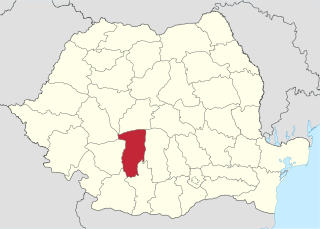
Vâlcea County is a county (județ) of Romania. Located in the historical regions of Oltenia and Muntenia, it is also part of the wider Wallachia region. Its capital city is Râmnicu Vâlcea.

The Kingdom of Romania was a constitutional monarchy that existed in Romania from 26 March 1881 with the crowning of prince Karl of Hohenzollern-Sigmaringen as King Carol I, until 1947 with the abdication of King Michael I of Romania, and the Romanian parliament proclaiming Romania a people's republic.

The Romanians are a Romance ethnic group and nation native to Romania, that share a common Romanian culture, ancestry, and speak the Romanian language, the most widespread spoken Balkan Romance language, which is descended from the Latin language. According to the 2011 Romanian census, just under 89% of Romania's citizens identified themselves as ethnic Romanians.

The Romania national football team represents Romania in international men's football competition, and is administered by the Romanian Football Federation. They are colloquially known as Tricolorii.

The Arieș is a left tributary of the river Mureș in Transylvania, Romania. It discharges into the Mureș in Gura Arieșului, 11 km southwest of Luduș. Its total length is 166 km (103 mi), and its drainage basin area is 3,005 km2 (1,160 sq mi).
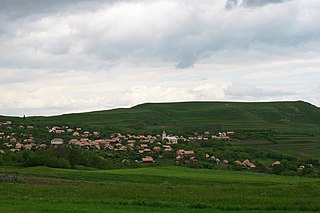
Iara is a commune in the southern part of Cluj County, Romania. It is composed of thirteen villages: Agriș (Ruhaegres), Borzești (Berkes), Buru (Borrév), Cacova Ierii (Aranyosivánfalva), Făgetu Ierii (Bikalat), Iara, Lungești (Szurdoklunzsest), Măgura Ierii (Járamagura), Mașca (Macskakő), Ocolișel (Felsőaklos), Surduc (Járaszurdok), Valea Agrișului (Egrespatak) and Valea Vadului (Vádpatak).
Dumbrava may refer to several places in Romania:

Cozieni is a commune in Buzău County, Romania. It is composed of twenty villages: Anini, Bălănești, Bercești, Ciocănești, Cocârleni, Colțeni, Cozieni, Fața lui Nan, Gloduri, Izvoru, Lungești, Nistorești, Pietraru, Punga, Teiș, Trestia, Tulburea, Valea Banului, Valea Roatei and Zăpodia.
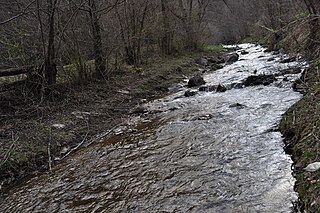
The Ocolișel is a small river in the Apuseni Mountains, Cluj County, western Romania. It is a left tributary of the river Arieș. It flows through the commune of Iara, and joins the Arieș near the village Lungești. In its upper course it is also called Vad or Valea Vadului. Its length is 25 km (16 mi) and its basin size is 51 km2 (20 sq mi).

The following outline is provided as an overview of and topical guide to Romania:

Bălăbănești is a commune in Galați County, Romania with a population of 2,080 people (2011). It is composed of four villages: Bălăbănești, Lungești, Bursucani and Zimbru. It also included two other villages until 2004, when they were split off to form Rădești Commune.
Lungești may refer to several places in Romania:

The 2019–20 coronavirus pandemic was confirmed to have reached Romania on 26 February 2020.

